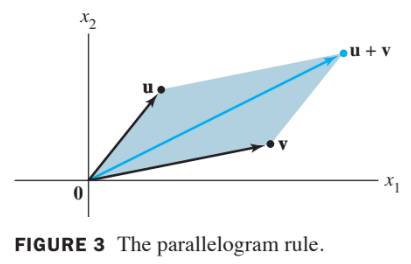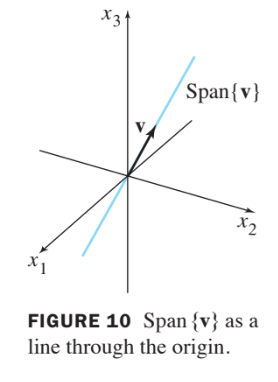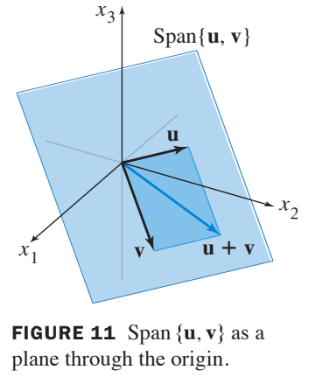Chapter 1. Linear Equations in Linear Algebra
1.3 Vector Equations
Important properites of linear algebra can be described with the concept and notation of vectors.
The term vector appears in a variety of fields, which will be discussed in Chapter 4, Vector Space.
Until then, vector will mean an ordered list of numbers .
Vectors in
- A matrix with only one column is called a column vector, or simply a vector.
- An example of a vector with two entries is
- where and are any real numbers.
- The set of all vectors with two entries is denoted by (read "r-two").
- The stands for the real numbers that appear as entries in the vector, and the exponent 2 indicates that vecotr contains two entries.
- Two vectors in are equal if and only if their corresponding entires are equal.
- Given two vectors and in , their sum is the vector obtained by adding corresponding entries and .
- Given a vector and a real number , the scalar multiple of by is the vector obtained by multiplying each entry in by
Example 1:
Gieven and , find ,, and .
Solution of Example 1
, , and
Geometric Descriptions of R Squared
- Consider a rectangular coordinate system in the plane. Because each point in the plane is determined by an ordered pair of numbers, we can identify a geometric point (a, b) with the column vector .
- So we may regard as the set of all points in the plane.
Parallelogram Rule for Addition
- If and in are represented as points in the palne, then corresponds to the forth vertex of the parallelogram whose other vertices are ,, and . See Fig. 3 below.

Vectors in R cubed and R to the Power n
- Vectors in are coulumn metrices with three entries.
- They are represented geometrically by points in a three-dimensional coordinate space, with arrows from the origin sometimes included for visual clarity.
- If is a positive integer, (read "r-n") denotes the collection of all lists (or ordered -tuples) of real numbers, usually written as column matrices, such as
Algebraic Properties of R to the Power n
- The vector whose entries are all zero is called the zero vector and is denoted by .
- For all in and all scalar and :
- , where denotes
Linear Combinations
Given vectors in and given scalars , the vector defined by
is called a linear combination of with weights .
- The weights in a linear combination can be any real numbers, including zero.
Exampel 5:
Let , and
Determine whether can be generated (or written) as a linear combination of and . That is, determine whether weights and exist such that
If vector equation (1) has a solution, find it.
Solution of Example 5
Use the definitions of scalar multiplication and vector addition to rewrite the vector equation
which is same as
and
- The vectors on the left and right sides of (2) are equal if and only if their corresponding entries are both equal. That is, and make the vector equation (1) true if and only if and satisfy the following system
- To solve this system, row reduce the augmented matrix of the system as follows:
- The solution of (3) is and . Hence is a linear combination of and , with weights and . That is,
In the Example 5, the original vectors , and are the columns of the augmented matrix that we row reduced:
- Write this matrix in a way that identifies its columns.
- A vector equation has the same solution set as the linear system whose augmented matrix is
- In particular, can be generated by a linear combination of if and only if there exists a solution to the linear system corresponding to the matrix (5).
Definition:
If are in , then the set of all linear combinations of is denoted by Span and is called the subset of Spanned (or generated) by . That is, Span is the collection of all vectors that can be written in the form
with scalars.
A Geometric Description of Span{v}
Let be a nonzero vector in . Then Span is the set of all scalar multiples of , which is the set of points on the line in through and .
See Fig. 10 below:

A Geometric Description of Span {u,v}
If and are nonzero vector in , with not a multiple of , then Span is the plane in that contains , , and . In particular, Span contains the line in through and and the line through and .
See Fig. 11 below:
